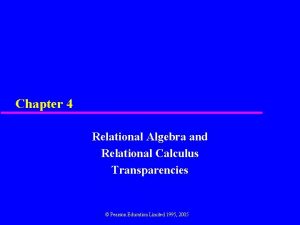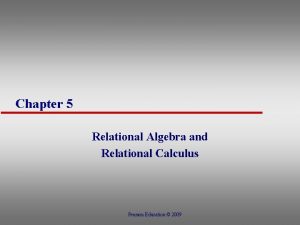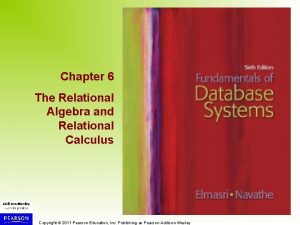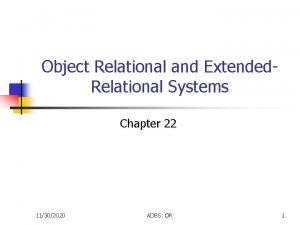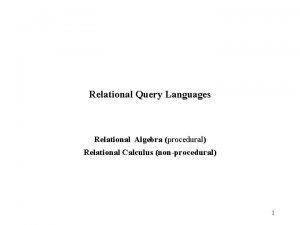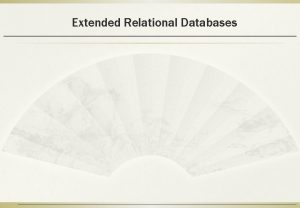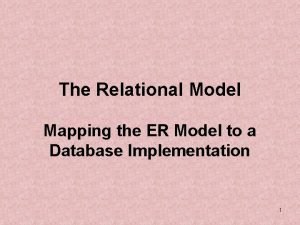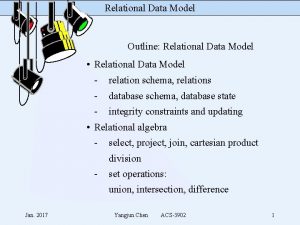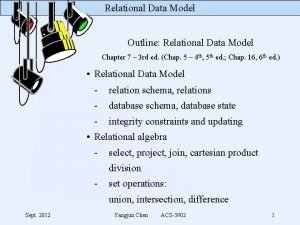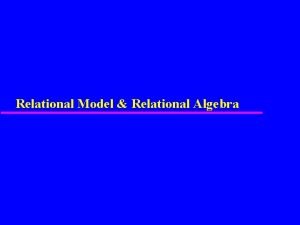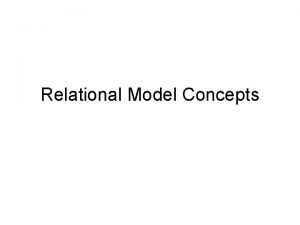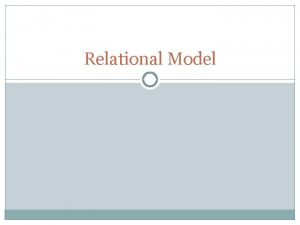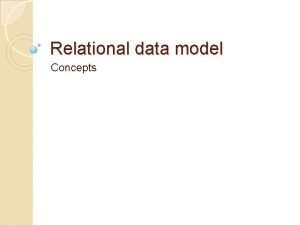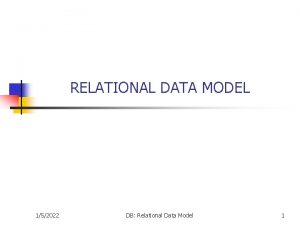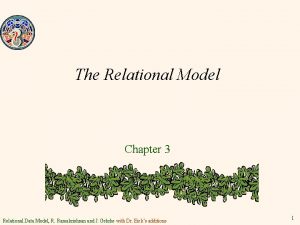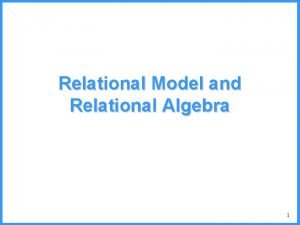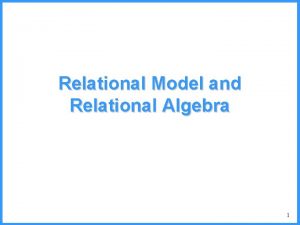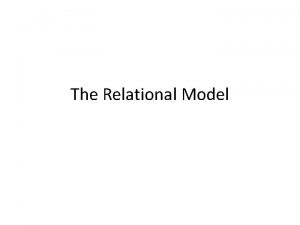Chapter 3 The Relational Data Model and Relational


![Component Values Notation n t 1. Name OR t 1[Name] = “Dick Davidson” t Component Values Notation n t 1. Name OR t 1[Name] = “Dick Davidson” t](https://slidetodoc.com/presentation_image/0cf8a6f44383e089cf198f4ca34fbaa6/image-3.jpg)










- Slides: 13

Chapter 3 The Relational Data Model and Relational Database Constraints Copyright © 2011 Pearson Education, Inc. Publishing as Pearson Addison-Wesley

Component Values Notation n We refer to of a tuple t by: n n n t[Ai] or t. Ai This is the value vi of attribute Ai for tuple t Similarly, t[Au, Av, . . . , Aw] refers to the subtuple of t containing the values of attributes Au, Av, . . . , Aw, respectively in t Copyright © 2011 Ramez Elmasri and Shamkant B. Navathe 2
![Component Values Notation n t 1 Name OR t 1Name Dick Davidson t Component Values Notation n t 1. Name OR t 1[Name] = “Dick Davidson” t](https://slidetodoc.com/presentation_image/0cf8a6f44383e089cf198f4ca34fbaa6/image-3.jpg)
Component Values Notation n t 1. Name OR t 1[Name] = “Dick Davidson” t 3[Gpa] = 3. 93 t 4[Ssn, Name] ={305 -61 -2435, “Benjamin Bayer”} Copyright © 2011 Ramez Elmasri and Shamkant B. Navathe 3

Relational Integrity Constraints n n Constraints are conditions that must hold on all valid relation states. There are three main types of constraints in the relational model: n n Key constraints Entity integrity constraints Referential integrity constraints Another implicit constraint is the domain constraint n Every value in a tuple must be from the domain of its attribute (or it could be null, if allowed for that attribute) Copyright © 2011 Ramez Elmasri and Shamkant B. Navathe 4

What is a key n n n We want to be able to retrieve every single piece of data that we putted into the database So, it is important to specify one attribute or more than one attributes which make it possible to uniquely identify every row in a table This attribute (s) is called a key This uniqueness ensure that we are retrieving exactly the row we want. The key can not be NULL Selecting a good key, is considered a challenge in the database design Copyright © 2011 Ramez Elmasri and Shamkant B. Navathe 5

Relational keys Super key (SK) n Candidate key (CK) n Primary key (PK) n Foreign Key (FK) n Copyright © 2011 Ramez Elmasri and Shamkant B. Navathe 6

Super Key n Is a set of attributes SK of R with the following condition: n n No two tuples in any valid relation state r(R) will have the same value for SK That is, for any distinct tuples t 1 and t 2 in r(R), t 1[SK] t 2[SK] This condition must hold in any valid state r(R) Every relation has one default super key which is the set of all its attributes Copyright © 2011 Ramez Elmasri and Shamkant B. Navathe 7

Super Key n n n SK 1 = {Name, Ssn, Home_phone, address, office_phone, Age, Gpa} SK 2 = {Name, Ssn} SK 3 = {Address, Ssn} Copyright © 2011 Ramez Elmasri and Shamkant B. Navathe 8

Candidate Key n n A superkey may contains additional attributes that are not necessarily for unique identification We are interested in identifying superkeys that contain only the attributes necessary for unique identification So, a candidate key is a superkey such that no proper subset is a superkey within the relation Example n SK 2 = {Name, Ssn} Proper Subset = {Ssn} n SK 3 = {Address, Ssn} Proper Subset = {Ssn} n Then SK 2 and SK 3 is not candidate key Copyright © 2011 Ramez Elmasri and Shamkant B. Navathe 9

Candidate Key n A candidate key, k, for a relation R has two properties n Uniqueness n n Irreducibility n n In each tuple of R, the values of k uniquely identify that tuple No proper subset of k has the uniqueness property For example suppose we choose CK 1 = {A 1, A 2, A 3} as a candidate key and we discovered that CK 2 CK 1 = {A 1, A 2} achieve uniqueness then CK 1 is not a candidate key Identifying the candidate key requires that we know the meaning of attributes in the real world so that we can decide whether duplicates are possible Copyright © 2011 Ramez Elmasri and Shamkant B. Navathe 10

Candidate Key n n Given the value of city , we can determine several branch office, So this attribute cannot be candidate key But given a branch. No we can determine at most one tuple Also, given a postcode we can determine at most one tuple Then branch. No and postcode are candidate keys Copyright © 2011 Ramez Elmasri and Shamkant B. Navathe 11

Primary Key n n n A primary key is a candidate key that is selected to identify tuples in the relation If a relation has several candidate keys, the minimal one is chosen arbitrarily to be the primary key. In ER the primary key attributes are underlined. Copyright © 2011 Ramez Elmasri and Shamkant B. Navathe 12

Primary Key n Example: Consider the CAR relation schema: n CAR(State, Reg#, Serial. No, Make, Model, Year) n CAR has two keys: n n Key 1 = {State, Reg#} Key 2 = {Serial. No} Both are also candidate keys of CAR n So a serial. No is selected as a primary key because it is minimal n CAR(State, Reg#, Serial. No, Make, Model, Year) In general: n Any key is a superkey (but not vice versa) n n for example {Serial. No, Make} is a superkey but not a key. Any set of attributes that includes a key is a superkey Copyright © 2011 Ramez Elmasri and Shamkant B. Navathe 13
 Relational algebra and relational calculus
Relational algebra and relational calculus Relational algebra to tuple relational calculus
Relational algebra to tuple relational calculus Relational algebra aggregate functions examples
Relational algebra aggregate functions examples Object relational and extended relational databases
Object relational and extended relational databases Relational query languages
Relational query languages What is the logical view of data
What is the logical view of data Extended relational data model
Extended relational data model Mapping of er model to relational model
Mapping of er model to relational model Hát kết hợp bộ gõ cơ thể
Hát kết hợp bộ gõ cơ thể Ng-html
Ng-html Bổ thể
Bổ thể Tỉ lệ cơ thể trẻ em
Tỉ lệ cơ thể trẻ em Chó sói
Chó sói Tư thế worm breton là gì
Tư thế worm breton là gì
